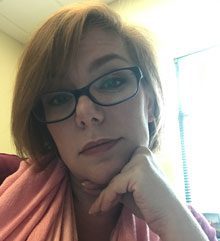Last weekend, I had the privilege of attending a funeral for my friend and fellow writer Vernie Singleton’s mother at Queen Chapel AME Church on Hilton Head Island. Having never attended an AME funeral previously, I’d no idea what to expect, but was in a state of awe and wonder from the minute I entered. A smiling usher welcomed me, guided me to a seat next to a wizened little grandma dressed in bright red, and gave me a 7 ½” x 10 ½” program the size of which could rival that of any menu in a New Jersey diner. (For the uninitiated, those diners serve everything all day, from a steak dinner with a baked potato the size of your head to a trucker-portion piece of New York cheesecake!)
This eight-page program was a virtual memoir of Dorothy J. Singleton’s life plus the order of service. A lovely full-color photo of her smiled from the cover. The dates of her “Birth”and “Death” were replaced by the far gentler “Sunrise” and “Sunset.” The following two pages were titled as “Obituary,” but read more like a eulogy/biography. Though we’d never met, after reading this, I felt as if we’d been acquainted for quite some time. Full-color family photos graced the next page, accompanied by a beautiful poem heralding the fact that Vernie’s mom Dorothy and dad Diogenese were “Together Again” and by the Prayer of St. Francis of Assisi.
The Order of Service followed, presided over by Dorothy’s niece, who’s a reverend. The songs were chosen by the family, and several were labeled “A Favorite Hymn,” which seemed wonderfully personal. The last couple of pages were filled with full-color pictures of Dorothy, her late husband, and her children, all with lots of smiles. No question that this is a close-knit family.
The very last page expressed individual gratitude to the health care and hospice teams that had helped “during her time of illness,” which turned out to be a couple of years. Her daughters and another family member tended to Dorothy during that time as well. This woman was much-loved.
By the time the service began, I felt fondly toward her, too. Parts of it could have been in any church, anywhere – prayers of consolation and scripture readings – all reverent, of course. And the music went soul-deep, all of it sung with sincerity and ebullience that brought joy to my heart.
However, my favorite part happened about two-thirds through and was described as“Reflections of Life.” Five different people took the microphone one at a time and talked about what Dorothy had meant to each of them. Those memories came from an aunt, several fellow Eastern Star members, a “soul sister”, a fellow church member, and a close friend. Some statedthoughts were warm, some humorous, some poignant, and all filled with obvious love.
At one point, the church’s fulltime reverend asked the family to stand, and seemingly half the seated attendees stood.
By the time the hour-and-a-half-long service had ended, I was mesmerized. Though the parameters of the service offered everyone a space to grieve as they chose, the overall atmosphere was one of celebration of an adored woman’s life and one of pure joy. I felt sort of like the Grinch, that my heart “grew three sizes that day.” I didn’t feel the way I usually do after a funeral, kind of sad with a sigh. I felt somehow changed and wanted to share the excitement. And then I realized that my feelings were those of an expanding worldview, not unlike some I’ve experienced when traveling and my perspective on an aspect or aspects of another culture grows when connecting with people who are not like me and I learn from them a bit about who they are. And it broadens my understanding. It’s all about worldview.
Indian – American film director, Mira Nair, whose production company is Mirabai Films, encapsulates the idea of a wide worldview nicely. “I am actually a resident of three worlds – of America, of India, and of Africa. I live in Uganda most of the year. It’s extraordinary to have that worldview that is an expansive one rather than just looking at the world from where you sit.”
Life becomes so much easier – and more pleasant – when one chooses to accept the fact that often, when confronted with one of life’s tricky situations or encountering a circumstance I’m not too familiar with, there’s actually more than one way of looking at it or thinking about it. Increasing your ability to see the world from many perspectives – or at least from more than one – helps to broaden your worldview, which can increase your capacity to understand and can make meeting with and working with folks who are different than you easier.
“We grow up to respect the gray,” says columnist Richard Cohen. “Black or white, one or the other, is childish. It represents the worldview of someone who does not know the world.”
Don’t misunderstand his viewpoint. He’s not referring to race here, but to different viewsof a situation. “Black or white” could mean how someone perceives a particular issue, situation, or idea, for example. To them, it’s one way or the other, with no room for shades of gray. These are people who might say, “It’s my way or the highway,” or “If you’re not with me, you’re agin’(i.e. against) me.” Pointing out a best case scenario, Cohen proffers that as we grow, hopefully, we learn enough about life to understand that in many situations, there’s not necessarily a good or bad, or a right or wrong side.
Says blockchain expert and securities attorney Alexandra Damsker, “Your thinking will always be limited to your own opinions and experience. So expand your worldview, experience, and opinions as much as possible.”
Her recommendations: Listen when people speak, rather than waiting to talk. Give your opinions, engage in arguments, and revise your perspectives. Seek out people with different backgrounds than yours. Take an art class, a comedy class, or go to concerts you’d usually skip.
“Be in your world,” she says.
Attending that funeral, a kind I’d never before experienced, changed my life for the better. Take a chance and try something new. You’ll likely grow from it.








